#Oncorhynchus
Explore tagged Tumblr posts
Text

This Amphicyon got lucky! It's prey, a large male Oncorhynchus rastrosus already spawned and was in the process of dying.
2K notes
·
View notes
Text
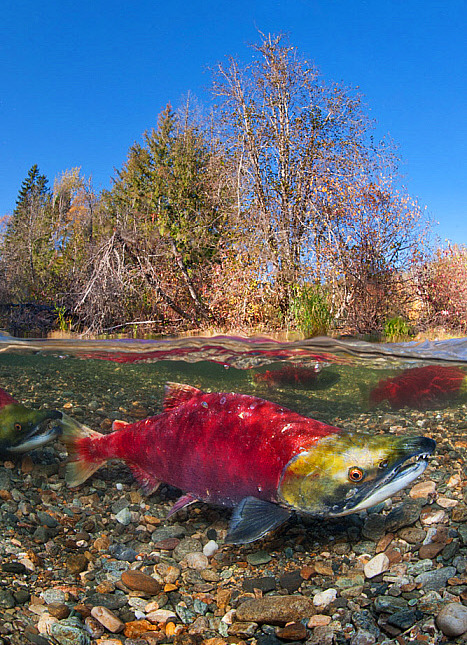

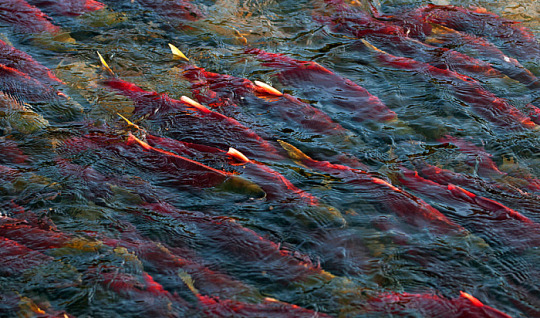
Male sockeye salmon (Oncorhynchus nerka) in Adams River, British Columbia
Photos by Alex Mustard
#Oncorhynchus nerka#Oncorhynchus#salmon#sockeye salmon#red#fish#red fish#male salmon#salmon river#adams river#river#river fish#british columbia#animals#wildlife#nature#breeding season
5K notes
·
View notes
Text
Oncorhynchus rastrosus
first art of 2025 is a fish! starting off strong a female Oncorhynchus rastrosus, the spike-toothed salmon. it's commonly misrepresented as a massive sockeye salmon with tusks slapped on, but we know that they didnt undergo any drastic levels of sexually dimorphic remodelling

for those who wonder what males look like, the majority of the dimorphism isnt noticeable as the it's present in internal skull bones and minor proportional differences, however, one way to tell is males only have one dentary tooth and lack the smaller additional premaxillary one
#paleoart#digital art#paleontology#digital artwork#artists on tumblr#palaeoart#digital illustration#sciart#id in alt text#palaeoblr#paleoblr#fish#fish art#extinct fish art#salmon#salmonid#Oncorhynchus#Oncorhynchus rastrosus#saber-tooth salmon#spike-toothed salmon
334 notes
·
View notes
Text
I wanted to bring to your attention this excellent documentary on spring Chinook salmon. They're one of the most endangered of the Pacific salmonids, and they face a variety of threats, from dams to climate change. They also have unique behaviors and traits that set them apart from other salmon, and recent genetic research shows that they're different even down to the level of their DNA.
It's only an hour long, and very well done; if you aren't able to just sit and focus on something for that long, it's good either watched in bite-sized chunks, or having on in the background while you do chores, art, etc. And while it does highlight some distressing realities, it leaves on a hopeful note, IMO.
#salmon#salmonid#salmonidae#Pacific salmon#chinook salmon#Oncorhynchus#fish#icthyology#vertebrates#wildlife#animals#endangered species#extinction#documentaries#nature documentaries#nature
528 notes
·
View notes
Photo

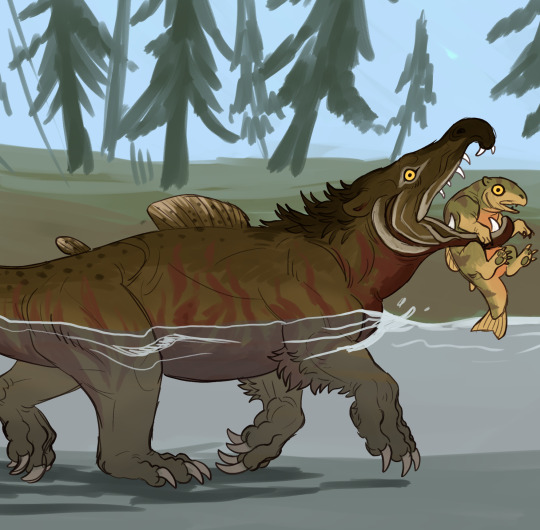
1: A newborn salmon chimera takes a rest after using a keratinized sheath on its snout analogous to an egg tooth to break free from one of the hundreds of eggs laid on the stream bed. At this point its limbs cannot even extend past its yolk sac, which incidentally makes for a perfect cushion. Newborns primarily use their strong tails to propel themselves through the water, and eventually develop their leg muscles as they hunt the stream beds for aquatic insects and mollusks.
2: A chum salmon chimera male brings one of its developing young to the surface to force it to learn to breath air for the first time. The vast majority of their several hundreds of offspring are predated upon within the first month, but mortality greatly decreases as they grow and the parents become more protective of individuals rather than the general vicinity.
#art tag#creature design#mostly lazy doodles cuz i am still dying of some sickness#salmon chimera#artists on tumblr#oncorhynchus
1K notes
·
View notes
Text

Each year between July and September, millions of sockeye salmon migrate from the Pacific back up rivers to the fresh waters of Lake Kuril, to spawn in the waters where they were born. This volcanic crater lake, in the South Kamchatka Sanctuary in the Russian Far East, is the largest sockeye salmon spawning ground in Eurasia. The annual glut attracts Kamchatka brown bears from the surrounding forests to feast on the fish and fatten up for hibernation. Following the example of the bears, Valter waded into the icy water to get the right perspective and to wait for an action moment - a real test of physical endurance. By doing so, 'I almost became one of them,' and 'in the silence of the Garden of Eden I did not think about anything else.' This bear reared up some three metres on its hind legs and scanned the water for fish. Suddenly it pounced on a female salmon swollen with roe, the force sending a string of crimson eggs spinning out of her body.
Brown Bear & Sockeye Salmon | Valter Bernardeschi
#dispatch#salmonidae#ursidae#salmoninae#ursinae#oncorhynchus#ursus#oncorhynchus nerka#ursus arctos#brown bear#sockeye salmon#valter bernardeschi
21 notes
·
View notes
Text
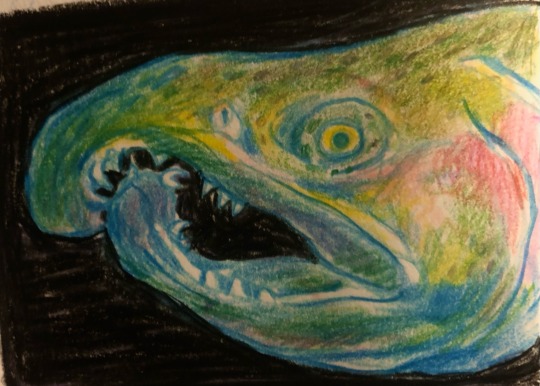

#me? fish posting?#traditional art#sketch#my art#coloured pencils#oncorhynchus#salmon#‘tis a coho and a chum
58 notes
·
View notes
Text

A steelhead (Oncorhynchus mykiss ssp. irideus) in Monterey Bay Aquarium, California
by marlin harms
#steelhead#rainbow trout#trout#fish#bony fish#Oncorhynchus mykiss ssp. irideus#Oncorhynchus mykiss#Oncorhynchus#salmonidae#salmoniformes#actinopterygii#chordata#captive animal#monterey bay aquarium
122 notes
·
View notes
Text
Rainbow Trout - Oncorhynchus mykiss
69 notes
·
View notes
Text
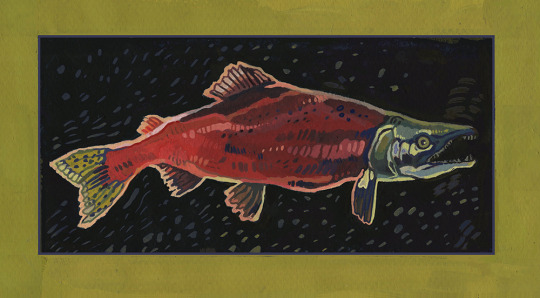
sockeye salmon
And the final guy in the new gouache fish gang is here! I mean I painted him months ago, but then, as always, I forgot to post him :'D The in(famous) horny fish!
#salmon#sockeye salmon#fish#gouache#illustration#art#There's this one dumb thing about these guys that's been bothering me all my life#besides their unusual transformation - their latin name is “Oncorhynchus nerka”#so they're called just “nerka fish” in Polish. Thing is#nerka means kidney in Polish and I always thought that t's named after it... funnily enough thar part of the name is of Russian origin and#basically#tied to the breeding season transformation of these guys) :' D that was a really random thing to mention but fr I had no idea why they're n
2K notes
·
View notes
Text

Rainbow Trout
#illustration#artists on tumblr#digital painting#digital art#my art#drawing#fish art#fishblr#oncorhynchus mykiss
42 notes
·
View notes
Text
Fish of the Day
Today’s fish of the day is the westslope cutthroat trout!

The westslope cutthroat trout, also known by scientific name Oncorhynchus lewisi is a common freshwater salmonid. Known by many names, this fish is one of the four living subspecies of cutthroat trout remaining, and the westslope is sometimes considered to have its own subspecies, as separated by major populations in differing rivers and lakes. Within their range, they tend to settle in rivers that contain more pools and vegetation cover, similar to other freshwater trout. Found across the Pacific Northwest, the westslope cutthroat trout is the Montana state fish, living in the lower areas of British Columbia, Alberta, Wahsington, Oregon, Idaho, and, of course, Montana. Primarily found within the Columbia basin and upper Missouri river basin, with historical ranges stretching far further North, South, and West, but now is only a shadow of its former size. This is due to the aggressive spread of other salmonid trout species, such as the brown trout and rainbow trout, which are non native in the areas and introduced by hobby fishers.

The name of cutthroat seems relatively straightforward, considering these fish are well known for teeth lining: the roof of the mouth, underside of the tongue, and clusters in the front of the mouth. This is in fact misleading. The name of cutthroat was given to these fish due to the distinctive red coloring to the lower jaw of the fish. Despite these many teeth, the cutthroat usually subsists on a diet of insects and their larvae, along with a healthy amount of zooplankton, and algaes. The westslope cutthroat in particular can grow to sizes of 6-12 inches, with few weighing more than 5 pounds. This is significantly smaller than most other inland cutthroat trout, which reach sizes of up to 39 inches at a maximum.

The life cycle and reproduction of the westslope cutthroat is the same as many other salmonids, migratory. cutthroat trout in particular though, especially landlocked ones such as the westslope have three different life strategies—stream resident, adfluvial, and fluvial. Stream resident fish are the ones living within river tributaries, never migrating to a fully different area, just to breeding grounds where the water is clear, clean, and oxygenated. Adfluvial fish live in larger lakes, and migrate down into river tributaries to lay eggs in areas of lower predation. Finally, fluvial fish migrate from larger rivers and basins into tributaries, just like the other trout. This all takes place in their breeding season in the spring, triggered by temperature change, as it begins as soon as the water temperatures regularly reach 50 degrees Fahrenheit. Female cutthroats can lay anywhere between 200-4,000 eggs a season, and after fertilization will hatch within a month into fry. Once they reach an age of 3-5 depending on subspecies the fish will begin doing migrations with others of their species to the same breeding grounds they were born in. The fish can live to reach as old as ten years of age, and survive through multiple breeding seasons, ushering in theoretically thousands of offspring in their life.

That's the westslope cutthroat trout, everybody! Have a wonderful day!
#fish#fish of the day#fishblr#fishposting#aquatic biology#marine biology#freshwater#freshwater fish#animal facts#animal#animals#fishes#informative#education#aquatic#aquatic life#nature#river#ocean#trout#cutthroat trout#westslope cutthroat trout#Oncorhynchus lewisi
35 notes
·
View notes
Text
To be honest I never hear anyone call them "king" and "silver". It's universally Chinook and Coho in the PNW (can't make a hand mnemonic with that though). Sockeye gets called that though. And no one mentions chum and pink at all…
did you memorize the 5 species of salmon in the pacific-northwest using a mnemonic on your hand? or do i gotta teach you?
28K notes
·
View notes
Text
Critter fact #3:

The Bonneville Cutthroat Trout, Oncorhynchus clarkii utah, is the state fish of Utah. It is identified by the red mark under its lower jaw, and the presence of many large, black spots.
#Just realized I didn't make a#3#At least i don't think so#Trout#Bonneville Cutthroat Trout#Oncorhynchus clarkii utah#fish#fish facts#critter facts
167 notes
·
View notes
Text

Baby fish
#fish#animals#wildlife#animal#forest#nature#beauty#photographers on tumblr#artists on tumblr#original photographers#original photography#photography#aesthetic#Washington#pnw#westcoastbestcoast#art#vsco#pacific northwest#explore#travel#cottagecore#p#probably Oncorhynchus clarkii
58 notes
·
View notes
Text

Les poissons 👍
#art#my art#digital art#art practice#wildlife art#fish#fishblr#new zealand longfin eel#anguilla dieffenbachii#koi#cyprinus carpio#rainbow trout#oncorhynchus mykiss#queue
103 notes
·
View notes